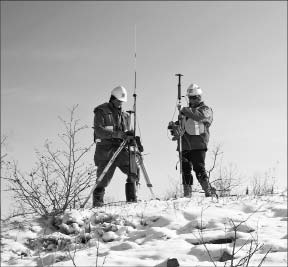Results of an optimization study and additional metallurgical tests have further de-risked Royal Nickel‘s (RNX-T) Dumont nickel project in Quebec, president and CEO Tyler Mitchelson says.
The optimization study showed that ore can be processed using a conventional front-end mill design with two semi-autogenous grinding (SAG) mills and four ball mills, rather than the four-stage crushing process followed by two ball mills contemplated in the September 2010 preliminary economic assessment (PEA).
Metallurgical test results on multiple samples with a combined weight of more than 2 tonnes of ore, meanwhile, confirmed that the de-sliming process can be completed in a single wet stage, similar to other existing operations, instead of the two-stage, dry-wet process outlined in the PEA.
“It changes our reagent scheme,” Mitchelson says. “Higher-cost re-agents disappear from the flowsheet so there are reductions in the op-ex.”
Mitchelson admits the potential benefits will be partially offset by the increased consumption of power seen with a more conventional SAG/ball mill front-end. But he believes the simplified flowsheet will be much more robust with lower initial capital and sustaining capital requirements, and lower operating and maintenance costs.
“This is an important milestone… simplifying flowsheets, knowing we can save costs, simplifying the re-agent scheme, overall it just de-risks everything and allows us to reflect these improvements in the prefeasibility, which gives the market more confidence,” he says.
Initial test results have also demonstrated higher grades. Open circuit cleaning tests on concentrate from about 200 kilograms of sulphide ore processed through the mini-pilot plant in Thetford Mines produced a very clean sulphide concentrate containing 35% nickel with magnesium oxide (MgO) levels of 3%.
“Our first real concentrate is twice the grade of what most are… we’re running at 35% and most concentrate grades are between 15% and 18%,” Mitchelson says.
And at 3% MgO, the concentrate can fit into any flash or electric smelter in the world, he notes. “It’s beyond what we thought… in our original target and estimates we were trying to get it down to 7%.”
Mitchelson says a preliminary feasibility study will be completed by the end of the third quarter or the start of the fourth quarter.
Dumont, about 25 km northwest of Amos in Quebec’s Abitibi mining region, would be the fourth-largest nickel sulphide operation in the world, he asserts.
According to the scoping study, the proposed open-pit mine could produce about 65,000 tonnes of nickel a year for at least 25 years. That works out to 140 million lbs. of nickel per year or about 4% of today’s global nickel production. By contrast, Vale‘s (VALE-N) Voisey’s Bay produces about 55,000 tonnes of nickel annually.
At presstime, Royal Nickel was trading at $1.64 per share and over the last year has traded between a low of $1.44 (May 11, 2011) and a high of $2.99 (Jan. 4, 2011). The company has about 88.6 million shares outstanding.


Be the first to comment on "Royal Nickel ‘de-risks’ Dumont"